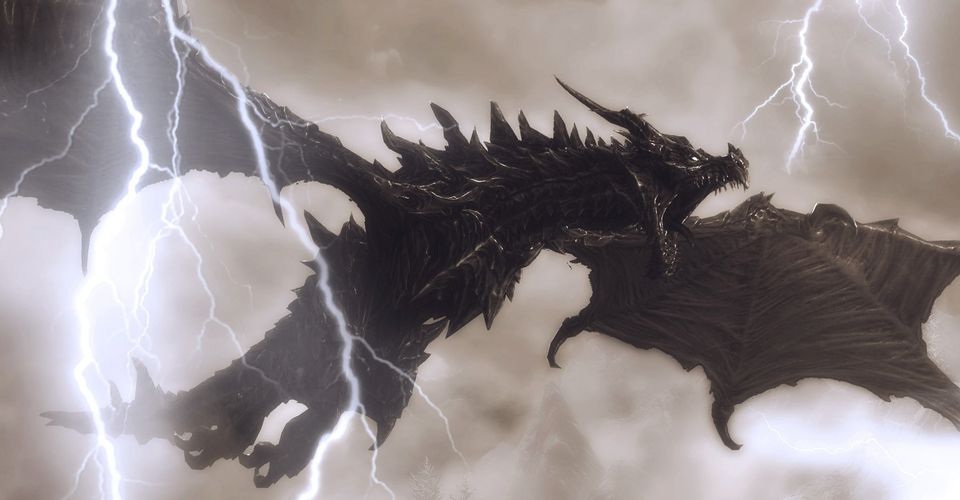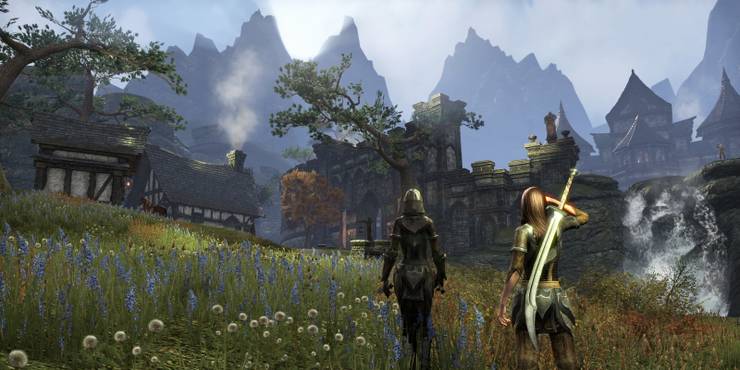Skyrim: How Dragon Breaks & Alduin Altered Elder Scrolls History

The lore of The Elder Scrolls and Skyrim is dense and intricate, spanning multiple millennia of in-game events, with one of the most bizarre being the Dragon Break. A Dragon Break is the name given to time-related anomalies found throughout Tamriel’s timeline in the Elder Scrolls games. Very little is known about Dragon Breaks, as they cannot be fully comprehended by mortal minds, but there are some scattered records of their existence and possible causes.
The concept of a Dragon Break was first brought to fans’ attention after the release of The Elder Scrolls II: Daggerfall. This game has multiple different endings depending on the choices a player makes during their journey. Bethesda, the creators of Elder Scrolls, claimed that any one of these endings was fully canon, but this caused some upset since not all of these eventualities could have taken place at the same time. The answer to this conundrum was the Dragon Break.
Named for the Aedric god of time, Akatosh, who is depicted as a dragon in The Elder Scrolls games, Dragon Breaks are temporal anomalies where time behaves in unexpected ways. They can be caused by a number of powerful magical or mechanical events and are characterized by “breaks” in time. This can manifest as multiple conflicting timelines existing alongside one another, or entire events being uprooted from history and ending up anywhere else in the past or future. Dragon Breaks also disrupt the collective memories of mortals, often leaving entire populations in confused wonderment about an event they are unable to understand.
What Can Cause A Dragon Break in Elder Scrolls

Dragon Breaks are momentous events that can send consequences rippling through time for eons past and those to come. The Divines and other Elder Scrolls gods and Daedra seem to have an understanding of how time is intertwined with the universe, and they know the consequences of meddling with it, but this is apparently not the case for mortals. Any time a Dragon Break has occurred, it’s usually caused by mortals delving into powers they know little about. Sometimes the motivations behind messing with the flow of time are noble, as in the case with the Nords who banished Alduin, but other times Dragon Breaks are caused by the greed and hubris of those who believed they could use time as a weapon.
Known Dragon Breaks In Elder Scrolls Lore – The Numidium

There are a few recorded cases of Dragon Breaks happening in The Elder Scrolls, three of which involve the Numidium, a massive brass golem created by the Dwemer. Towards the end of the First Era, the Dwemer of the Elder Scrolls and Skyrim built this immense automaton with the ability to shatter time, intending to use it as a weapon of war. The construct, however, had power beyond their understanding, and when it was activated in a war against the Chimer, it caused a Dragon Break. The timeline had been breached by the Numidium in what was later known as the Red Moment and, due to the unknowable consequences of the Numidium’s misuse, the Dwemer disappeared off the face of Tamriel, never to be seen or heard from again.
Nobody knows where the Dwemer ended up. Theories range from them being instantly erased from existence to them being thrust to another point in time, perhaps far into the future. The Numidium survived the event and was eventually used two more times, once by the Tiber Septim – of Elder Scrolls famous Septim Dynasty – to defeat the Aldmeri Dominion, and again in a muddling series of events known as the Warp in the West. The latter involved a truly perplexing battle where, somehow, five different nations all had the unique totem needed to control the Numidium, the ensuing battle unbelievably ending in the Empire’s favor. How this happened is up for debate, since the history of that war is as warped and perplexing as the Dragon Break that it caused.
Known Dragon Breaks In Elder Scrolls Lore – The Middle Dawn

The largest and most well-known Dragon Break is known as the Middle Dawn, said to have taken place in the First Era and to have lasted for just over a millennium. Tamrielic scholars and historians disagree on the exact cause and effects of this Dragon Break, but most are certain that it came about due to a religious sect’s attempts to meddle with the Divine. They wanted to separate the aspects of Akatosh, an Imperial god, from Auriel, the mer god, most prominently represented by the Snow Elves in Skyrim‘s Dragonborn expansion, who later mutated into the Falmer as one of Elder Scrolls‘ sinister elves. The two Divines had largely been conceptualized as the same being, but these elven worshippers disliked the Empire’s influence on their deity.
It is speculated that they used a powerful artifact known as the Staff of Towers, but this is not confirmed. The end result, however, was a temporal rift that most likely had something to do with Akatosh, being the god of time. The effects of this Dragon Break were minor, but they did result in various inconsistencies in documented history, conflicting stories overlapping and making certain events coincide despite being completely illogical. The Amulet of Kings, an ancient Akatoshian artifact held by Elder Scrolls‘ Emperors of Tamriel, is capable of confirming when a Dragon Break has occurred.
The Time-Wound Is A Dragon Break Referenced In Skyrim

One more known Dragon Break (although it is debated whether it truly qualifies as one), is the event that banished Alduin to the future. In the midst of the Dragon War, a conflict where mortals rebelled against the rule of dragons in Skyrim, Alduin proved impossible to defeat. Having been beseeched by Kyne to do so, Parthunaax, Alduin’s brother and former lieutenant, taught mortals to use the Voice, or Thu’um, to shout as dragons do.
A group of brave Nord heroes used the Voice to manipulate time, casting the evil dragon into the future, where the Last Dovahkiin could defeat Alduin during Skyrim‘s events. This resulted in a Time-Wound existing atop the tallest peak in Skyrim, where some say the Throat of the World still passes in and out of present time. By all accounts, this would be considered as a Dragon Break since the timeline was indeed disrupted by mortals.
How Dragon Breaks Can Explain Plot Holes

Since the nature of Dragon Breaks revolves around the fact that they are inconsistent, confusing, and contradictory, this naturally allows some breathing room for writers. If any find themselves having two storylines that conflict or events that could not have happened in the way they were written, a Dragon Break is the logical escape. While this can possibly be considered as a more unscrupulous method of avoiding criticism, it is intended as a failsafe when organizing thousands of years worth of Elder Scrolls lore. It is extremely difficult to align so much content in a credible and coherent way when new additions are constantly made and countless fans can comb through the universe’s history with a finer lens than any writer could hope to have on their own.
It goes without saying that the concept of the Dragon Break is a way in which plot holes and inconsistencies can be explained away since temporal anomalies in The Elder Scrolls can result in collective memory loss among entire nations of people. There are certainly some cracks in the storytelling of the franchise, but using the idea of time being fluid and unpredictable is a creative way of addressing any inevitable mistakes. In such a vast and complex universe, it is totally believable that some things can only be explained by unbelievable means, and this is an important concept to Skyrim and undoubtedly in future Elder Scrolls games to come.
About The Author
















